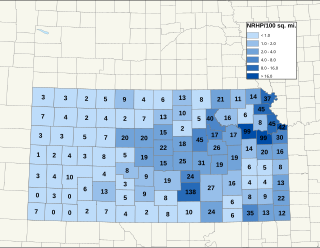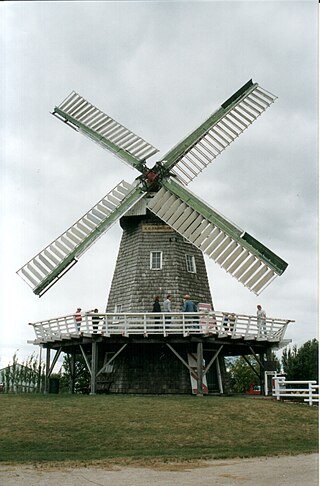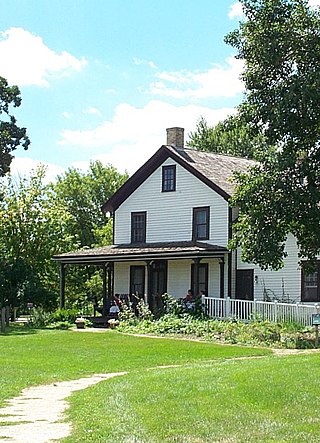
The Great Plains, sometimes simply "the Plains", is a broad expanse of flatland in North America. It is located just to the east of the Rocky Mountains, much of it covered in prairie, steppe, and grassland. It is the western part of the Interior Plains, which also include the mixed grass prairie, the tallgrass prairie between the Great Lakes and Appalachian Plateau, and the Taiga Plains and Boreal Plains ecozones in Northern Canada. Great Plains or Western Plains is also used to describe the ecoregion of the Great Plains, or alternatively the western portion of the Great Plains.

A dugout or dug-out, also known as a pit-house or earth lodge, is a shelter for humans or domesticated animals and livestock based on a hole or depression dug into the ground. Dugouts can be fully recessed into the earth, with a flat roof covered by ground, or dug into a hillside. They can also be semi-recessed, with a constructed wood or sod roof standing out. These structures are one of the most ancient types of human housing known to archaeologists, and the same methods have evolved into modern "earth shelter" technology.

A hut is a small dwelling, which may be constructed of various local materials. Huts are a type of vernacular architecture because they are built of readily available materials such as wood, snow, ice, stone, grass, palm leaves, branches, clay, hides, fabric, or mud using techniques passed down through the generations.

Buffalo Bill Ranch State Historical Park, known as Scout's Rest Ranch, is a living history state park located west of North Platte, Nebraska. The ranch was established in 1878 with an initial purchase of 160 acres south of the Union Pacific tracks by William Cody. The 4,000 acre ranch was sold in 1911 and has been under the management of the Nebraska Game and Parks Commission since 1964. The 25 acre historic state park, added to the National Register of Historic Places in 1978 and designated a National Historic Landmark in 2021, is open weekdays from April to October. The house and outbuildings can be toured, including a museum documenting Cody's life from a Pony Express rider to his Wild West shows.

There are over 1,600 buildings, sites, districts, and objects in Kansas listed on the National Register of Historic Places in Kansas. NRHP listings appear in 101 of the state's 105 counties.

Mennonite Heritage Village is a museum in Steinbach, Manitoba, Canada telling the story of the Low German Mennonites in Canada. The museum contains both an open-air museum open seasonally, and indoor galleries open year-round. Opened in 1967 and expanded significantly since then, the Mennonite Heritage Village is a major tourist attraction in the area and officially designated as a Manitoba Signature Museum and Star Attraction. Approximately 47,000 visitors visit the museum each year.
A burdei or bordei is a type of pit-house or half-dugout shelter, somewhat between a sod house and a log cabin. This style is native to the Carpathian Mountains and forest steppes of Eastern Europe.

The Stuhr Museum of the Prairie Pioneer is a museum located in Grand Island, Nebraska dedicated to preserving the legacy of the Pioneers who settled the plains of central Nebraska in the late 19th century. It features a living history village called Railroad Town, designed to evoke an 1890s-era prairie village and made up of many original period structures moved to the museum.
Addison Sod House is a Saskatchewan homestead site made of grass or sod which is over a hundred years old and has been designated as a National Historic Site of Canada.
The Plains Conservation Center is an outdoor education center and state-designated natural area in Aurora, Colorado. The Aurora property is owned by the Aurora Parks, Recreation and Open Space department.
There are numerous heritages and cultural attractions in the province of Saskatchewan. Museums, dinosaur digs, aboriginal cultural and heritage sites, art galleries, professional sport venues, spas, handcraft, antique and tea shops, agricultural tours, theatre and archaeological sites comprise over 600 varied Saskatchewan institutions.

The Gibbs Farm is a museum in Falcon Heights, Minnesota, United States. The site was once the farmstead of Heman and Jane Gibbs, first built in 1854; the existing farmhouse includes the small, original cabin. The museum seeks to educate visitors on the lives of 19th-century Minnesota pioneers and the Dakota people who lived in southern Minnesota before the arrival of Europeans.

The Cottonwood Ranch is a historic site near Studley in Valley Township, Sheridan County, Kansas, United States. The ranch is now preserved as a Kansas State Historic Site.

The Pilgrim Holiness Church, also known as the Baled Hay Church or the Baled Straw Church, is a church built in 1928 in Arthur, Nebraska. At a time and place in which conventional construction materials were expensive or unavailable, it was built out of baled rye straw. For its unique mode of construction, associated with the history of settlement of the Nebraska Sandhills, it is listed in the National Register of Historic Places.

The Pioneer Sod House, now known as the Wheat Ridge Museum and Sod House in Wheat Ridge, Colorado is a sod house built in 1886 or perhaps well before. It was listed on the National Register of Historic Places in 1973.

The Minor Sod House, also known as Minor Post Office, near McDonald, Kansas, is a sod house that was built c. 1907.

The Wallace W. Waterman Sod House near Big Springs, Nebraska, United States, is a sod house built in 1886. It was modified in 1925 for continued use, including a layer of concrete being applied to the exterior walls. It was listed on the U.S. National Register of Historic Places in 1995. The listing included two contributing buildings, the second being a small outbuilding from 1925.

The William R. Dowse House, more commonly known as the Dowse Sod House, is a sod house in Custer County in the central portion of the state of Nebraska, in the Great Plains region of the United States. It was built in 1900 and occupied until 1959. After a long period of neglect, it was restored beginning in about 1981, and opened as a museum in 1982.


















